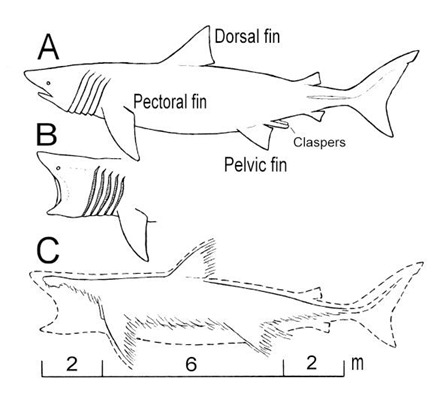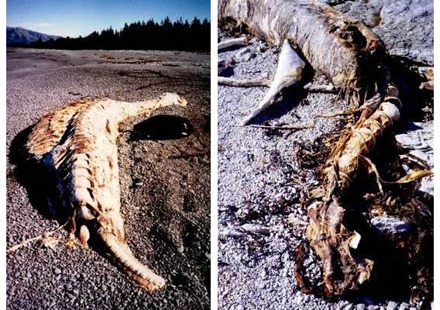The Shark Theory
Several scientists believed that the Zuiyo Maru had simply pulled up the body of a basking shark. According to the Oceans Magazine article, Dr. Bobby Schaeffer, curator of vertebrate paleontology at the American Museum of Natural History in New York City said,
“It’s baloney. Every ten years or so, something is found, usually in the Pacific, and people think it’s a dinosaur. And it always turns out to be a basking shark, or an adolescent whale. When sharks find a dead whale, they have a merry old time, and the half-eaten corpse looks like a dinosaur skeleton.”
Dr. Alwyne Wheeler of London’s Natural History Museum echoed Schaeffer’s sentiments in a 1977 New Scientist article.
“Sharks are cartilaginous fish. When they start to decompose after death, the head and gills are first to drop from the body … Greater experts than the Japanese fishermen have been foiled by the similarity of shark remains to a plesiosaur.”
A diagram in a 1997 article from Reports of the National Center for Science Education depicts similarities between the decayed remains of a basking shark and whatever was pulled up onto the Zuiyo Maru:
The Science
The fibrous tissue that Yano pulled from one of the creature’s fins was tested and, according to the Reports of the National Center for Science Education article, the tissue contained elastoidin, “a collagenous protein known only from sharks and rays (not reptiles or even other fish).” Furthermore, the levels of several amino acids found in the sample either matched or were found to be very close to the levels in a sample from a known basking shark.
While some still question the scientific evidence, it appears that the shark theory holds up for plenty of researchers, scientists, and academics. That hasn’t stopped weird looking carcasses from washing up on shore in New Zealand. Two strange looking animals were found on the same stretch of New Zealand’s Kaikoura Peninsula within three months of each other; one in December of 1998 and the other in January of 1999.
And while “the first reaction from mainstream scholars was that the photographs showed nothing more than two massively decomposed carcasses of what were once basking sharks,” according to AmericanMonsters.com, you’d be forgiven for wondering what in the world you were looking at if you happened to come across one of them.
Further Reading
New Nessie (Wikipedia)
What Was the New Zealand Monster? (Oceans Magazine)
Sea-monster or Shark? An Analysis of a Supposed Plesiosaur Carcass Netted in 1977 (Reports of the National Center for Science Education)
New Zuiyo Maru Cryptid Observations–Strong Indications It Was a Marine Tetrapod (Creation Research Society Quarterly Journal)
Plesiosaur (Wikipedia)
Basking shark (Wikipedia)
ZUIYO-MARU CARCASS (American Monsters)
KAIKOURA CARCASSES (American Monsters)



